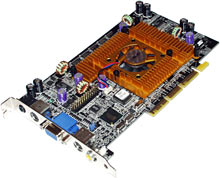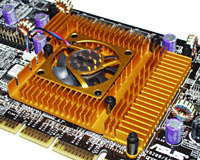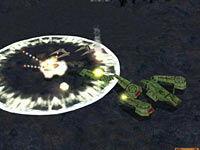
Asus V8200 Deluxe GeForce3 graphics card
Review date: 23 May 2001. Last modified 03-Dec-2011.
Whenever a new Nvidia video card chipset comes out, you can count on Asus to produce a graphics card that uses it in short order. And if that board has "Deluxe" in its name, as it often does, you can also count on it being rather imposingly expensive.
So it is with the new GeForce3 chipset, which powers the Asus AGP-V8200 Deluxe. This, people, is a video card that costs nearly a thousand Australian dollars - $AU990 delivered, from Aus PC Market (Australian shoppers who just can't wait can click here to go to the Aus PC site and place an order!). As I write this, the low ex-shipping US price for the V8200 Deluxe is still more than $US430, if you believe Pricewatch. Which, at the bottom end of the price scale, is not usually a good idea.
Other GeForce3s, like the PixelView one I review here, cost about $AU150 less than the V8200, ex shipping.
Like everybody else's GeForce3, the V8200 is very, very fast. Even on current software that doesn't take advantage of the programmable rendering features of the new chipset, you can do things like use Full Screen Antialiasing (FSAA) in 1280 by 960 resolution, 32 bit colour, and still find your CPU to be the limiting factor for frame rate in a startlingly large number of games.
Also like everybody else's GeForce3, the V8200 has big shiny heat sinks on its core chip and memory. And 64 megabytes of that memory, which is more than you need for just about anything that anyone's playing today.
So why's the Asus board cost more than the competition?
Bells and whistles, that's why. Bells and whistles.
What you get
The full V8200 Deluxe kit gives you rather more than the plain video-card-and-a-driver-disc package that bargain basement cards offer.
For a start, there are these things.
These style-free shades are LCD shutter glasses, and they plug into one of the five (!) connectors on the back of the video card.
Shutter glasses, together with appropriate driver software, let you view your games or other 3D applications in proper, genuine 3D. Each eye sees a different image. You don't get head tracking - you can't move your head to one side to see behind something - but the effect is still quite impressive.
When I first reviewed the Asus shutter-glasses almost two years ago (the review's here), I didn't like them at all. LCD glasses were - and are - the only affordable way to get a genuine 3D experience on your PC, but they have some serious limitations.
Back then, the Asus driver support for the glasses was lousy. Today, it isn't; the LCD specs work with pretty much any 3D game (Direct3D or OpenGL) you care to name, and you don't have to run and quit the game a zillion times while you set the glasses up, and you're not likely to be plagued with crashes.
But the hardware limitations remain. Shutter-glasses work by rapidly alternating two images on the monitor, one for each eye, and blacking out the lens in front of each eye in turn so that each eye only gets to see the image that's meant for it. Now, that's great in theory, but in practice LCD panels can't black out completely. Some light always gets through. So each eye sees the image that's meant for it, but also sees a dim ghost of the image that's meant for the other eye. The result's an odd triple-vision sort of effect.
Going to 3D mode also halves your frame rate - not a huge problem, with GeForce3 muscle - and requires a really high monitor refresh rate if you want to avoid nasty flicker. To get that refresh rate out of most current screens, you need to run in a relatively low resolution. Which puts a bit of a damper on the pretty-factor.
Still, lots of people really like shutter-glasses, and it's not as if there's any other cheap-ish way to get true 3D games yet. So you'll like 'em, if they're the sort of thing that you like.
The layout of the V8200 is significantly different from that of simpler GeForce3 boards; Asus have diverged considerably from the "reference" GeForce3 design to fit their own stuff in.
All GeForce3s have an imposing set of heat sinks on the main chip and the RAM, but the V8200's heat sink complement is unusual. It looks like one solid piece of anodised aluminium, at a glance, but the RAM sinks actually don't touch the main sink. This is sensible, and by design.
The GeForce3 core is a pretty warm chip; it runs about as hot as the original GeForce 256; the GeForce2 runs considerably cooler. Because of the not inconsiderable heat output from the core chip, the main fan-assisted heat sink doesn't need heat soak from the RAM chips adding to its load. Hence, no connection. Fortunately, the RAM chips don't actually need much cooling, even at their 230MHz-times-two Double Data Rate (DDR) clock speed. The finned heat sinks on the V8200 memory should be more than adequate.
Ins and outs
The back of the V8200 Deluxe is only just big enough for all of the connectors.
From left to right in the above picture, there's the connector for the 3D glasses, the video input connector, the standard 15 pin D-sub VGA connector, the S-Video output (for higher quality TVs, VCRs and camcorders) and the composite video output (for pretty much everything else).
The video input connector is a dual-mode socket. It's got the normal complement of S-Video pins, so you can plug a mini-DIN Y/C cable straight into it. But it also has three more pin-holes, two of which can accept composite video input. A little adapter cable that comes with the card plugs into the video input and gives you a normal RCA socket for composite video.
You also get an RCA cable and an S-Video cable, which is nice. Most cards with S-Video connectors don't give you a cable.
The V8200 Deluxe drivers support TV output of resolutions up to 800 by 600, which is pretty much the industry standard. Some video cards support higher TV output resolution, but since even very expensive standard definition TVs have a hard time clearly displaying 640 by 480, the higher resolution support is really just a convenience factor for people who want to be able to see some sort of view of their high-res Windows desktop while they're setting up their business presentation, DVD movie or game on the big screen. There just isn't room for that much resolution in a composite or Y/C video signal; the video card throws the extra resolution away in the encoding process.
If you plan to spend considerable time displaying stuff on your huge TV, by the way, then you do not need a GeForce3. The big deal about this chipset, with current games, is that it can display very high resolutions and maintain a very high frame rate. Since 640 by 480 is plenty for even giant TVs, and 25 or 30 frames per second (for PAL and NTSC, respectively) is the most a TV can manage, an inexpensive GeForce2 MX card with TV out will do just as well as a behemoth like the V8200 for that purpose.
The V8200 Deluxe supports PAL and NTSC, by the way. Some video cards come in different versions for different markets, which annoys people who buy a card from overseas and find it doesn't work with their local TV standard; the V8200 is not one of those cards.
On the video input side, the V8200 Deluxe can capture video at resolutions up to 740 by 560, which pretty much matches the highest resolution you'll get from a Y/C connection. There's no such thing as an exact resolution match when you're talking analogue video; analogue video formats have a definite number of lines (625, full overscan, for PAL; 525 for NTSC) but no definite number of pixels per line. I explain this in more detail in my video guide here.
The V8200 uses a Video In/Video Out (VIVO) chip that handles both functions in one package. Most video cards with TV ins and outs use one chip for each function.
From a user's point of view, there's nothing exciting about this new hardware; it doesn't have fancy whole-frame scaling technology (to improve the apparent resolution of TV output), and it doesn't have hardware video compression either. When you grab video with the V8200, all of the encoding work has to be done by your CPU - which means you can't get a whole lot of compression unless you capture at a low resolution and frame rate.
There's nothing stopping you capturing with very low compression and just flogging tons of video down onto your hard drive, if you've got the space; you can recompress it later to some more storage-friendly format. But like other TV-in/TV-out video cards, the V8200 Deluxe is not a real video editing board. If you want to do proper entry-level editing, you'll be better off with any old graphics card and a cheap dedicated editing board with hardware compression, like a Pinnacle Studio DC10plus, for instance.
Software bundle
Enough CDs for you?
Along with the main driver disc, the V8200 Deluxe comes with Asus' usual bundle of maybe-useful utilities, plus some unusually desirable extras.
Starting with the boring stuff, there's the E-Color's 3Deep gamma correction software, CyberLink's VideoLive Mail 4, and the basic but useable enough Asus Live video capture utility.
In the useful-if-you-need it department, there's AsusDVD 2000, a software DVD playback program that's based on Cyberlink's excellent PowerDVD and is, thus, a worthwhile piece of software. Provided you've got a DVD-ROM drive and want to use your PC as a DVD player, that is.
You also get Ulead Videostudio 4.0 (not the limited "SE" version), which is a home-userish but perfectly adequate video editing package. It's no Adobe Premiere, but then it doesn't have a $US549 price tag, either.
You also get three quality games - Messiah, Sacrifice and Star Trek: New Worlds. None of them are particularly new, but they're worth having.
Messiah's a pretty and quite playable 3D action game in which the player character is probably the first ever to wear a nappy...
...Sacrifice is a gratuitously gorgeous fantasy Real Time Strategy epic...
...and New Worlds is another RTS tarted up in Trekkie duds, but nonetheless somehow manages to not suck.
Performance
One graphics card with a given chipset, clock speed and driver version will run at exactly the same speed as another, and that's the situation with the V8200 Deluxe.
There are still no actual games that use the GeForce3's extra rendering capabilities, so you only get value for money out of the chipset if you really dig DirectX 8 benchmarks like 3DMark 2001, or if you've got a good-sized monitor - 19 inch at least.
In 3DMark 2001, the GeForce3 tramples everything that came before it; it's about twice the speed of a GeForce2 GTS, and there are some tests that no other graphics card can yet even run.
In high resolutions - above 1024 by 768, and especially if you use FSAA to smooth out the jaggies - the GeForce3 beats the older GeForce2 Ultra by a steadily increasing margin as the number of pixels being pushed increases. The GeForce3's "quincunx" antialiasing system gives roughly 4X FSAA quality at a 2X FSAA frame rate price, which makes higher-than-1024-by-768 antialiased games thoroughly playable. Even in hectic multiplayer battles.
The GeForce2 Ultra made a good stab at this, but for really good frame rates you generally still had to drop a resolution notch or two. Having to reduce your resolution in order to turn on antialiasing sort of defeats the purpose. Now, you don't need to any more.
Overclocking
With its impressive heat sinks, you might expect the V8200 Deluxe to have a bit more core and RAM overclockability up its sleeve than less imposingly cooled GeForce3s. Well, it does, but it doesn't really matter.
The V8200's core seems happy (with decent case airflow) up to better than 220MHz, versus maybe 210MHz for the PixelView card I reviewed before. The RAM overclockability, though, doesn't seem to be any better; OK, maybe this card can do 530MHz RAM speed (versus 525MHz for the PixelView) before it starts glitching up, but I wouldn't bet my life on it. It depends on how many twinkling white pixels seen out of the corner of your eye you can stand.
What's this overclock add up to? Maybe 10% better frame rates at 1600 by 1200. Maybe less. Definitely less, at lower resolutions. So don't get too excited.
Some people have reported considerably higher overclocks with V8200s, but nobody's managed to wring more than about 15% more performance out of this board in any test I've seen. You might be able to see that much of a difference, if you've got a really pretty game running in a really high resolution. If someone set your card back to stock speed, though, I wouldn't be surprised if you never noticed.
If you love to overclock, I suggest you devote your attention to your CPU instead.
SmartDoctor
Like various other recent Asus cards, the V8200 Deluxe includes a hardware monitoring chip that allows it to keep track of its supply voltage, temperature and fan speed. By using the included "SmartDoctor" utility, you can set the system up to sound an alarm if the card cooler fan fails or gets jammed. You can also get a warning if your AGP slot voltage is sagging - indicative of an over-stressed motherboard power regulator, which can cause huge annoyance if you don't know what's making your computer crash five minutes into every 3D game.
SmartDoctor can also dynamically change the clock speed of the card in response to its temperature and what you're doing. This makes it pretty much impossible for the graphics card to overheat; if it gets too hot, it slows down.
This feature's quite handy if you've got a mission-critical demo machine that's going to be grinding away on heavy-duty 3D at a trade show, or something; it significantly reduces the chance that you'll be made to look like a clown by an unexpected blue-screen. And it also lets tweak-happy overclockers wind up the card speed and then plunge into the high-commitment multiplayer game of their choice with less chance of crashing out just when they're about to finally clean the clock of that irritating kid that's been trash-talking at them all night.
But if you're not fooling around with overclocking, and your computer has halfway reasonable ventilation, a GeForce3's not at all likely to overheat anyway. And if you are overclocking, you don't want SmartDoctor hauling on the handbrake five degrees shy of the point where the card's actually likely to have problems.
SmartDoctor has to do this, of course; if it waited to wind the clock speed back until the card was already so hot it'd gone flaky, it'd probably end up hanging along with the rest of the computer. But there's no way for SmartDoctor to know how much hotter than its "trigger temperature" the card might get; it may be guarding against a problem that'll never arise.
SmartDoctor's warnings are also still rather impolite - it flicks back to Windows to show you its alarm pop-up. Which can wreck your game all by itself, especially if the game doesn't like switching back to the desktop, and hangs the computer instead.
Overall
If you want TV out and/or in, and you like the idea of 3D shutter-glasses, and you wouldn't mind the games bundled in with the V8200 Deluxe, it's a great board. Not stupidly expensive for what you get.
If you don't need the frills, though, you don't need the Deluxe. Asus also make "Pure" versions of their cards without all the extra ins and outs and accoutrements; the V8200 Pure isn't out yet, but there are more and more other similar GeForce3 products hitting the streets every day.
If you want the GeForce3 Bells, Whistles And Gongs Edition, though, the V8200 Deluxe is definitely the graphics card for you.










